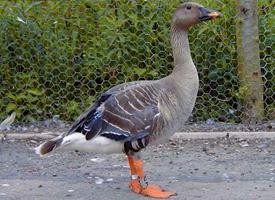
Descrierea animalului
The Bean Goose, scientifically named Anser fabalis, is a captivating species of wildfowl belonging to the family Anatidae, which encompasses ducks, geese, and swans. This species is notable for its considerable size, elegant appearance, and fascinating migratory patterns, making it an object of interest among birdwatchers and ornithologists.Physically, the Bean Goose presents a robust body, a relatively long neck, and a large head, with adults typically reaching a length of 68 to 90 cm and boasting a wingspan that can extend from 140 to 174 cm. The weight range for this species varies significantly, with individuals weighing anywhere between 1.7 to 4 kg, depending on the subspecies, age, and time of year. Their plumage is primarily brownish-gray, which provides excellent camouflage in their natural habitats. The breast is lighter, often showing a more buff or pale brown coloration, while the belly may display faint barring. A distinctive feature of the Bean Goose is its bill, which is black at the tip and base but shows an orange or pink band in the middle, although this can vary among the different subspecies.
There are several subspecies of the Bean Goose, which are primarily differentiated by their breeding and wintering ranges, as well as slight variations in size and plumage. The most commonly recognized subspecies include the Taiga Bean Goose (A. f. fabalis) and the Tundra Bean Goose (A. f. rossicus), with the former breeding in the taiga zones of northern Europe and Asia and the latter in the tundra regions further north.
The Bean Goose is a migratory bird, with most populations traveling significant distances between their breeding and wintering grounds. The breeding habitat of the Bean Goose includes the taiga forests and tundra of northern Europe and Asia, where they nest on the ground, often on islands in lakes or in dense vegetation to avoid predators. Their nests are made from plant material and lined with down. In winter, they migrate to more temperate regions, including parts of Europe, the British Isles, and Asia, where they can be found in a variety of wetland habitats, from large lakes and rivers to marshes and flooded fields.
The diet of the Bean Goose primarily consists of plant material. During the breeding season, they feed on a variety of tundra vegetation, including sedges, grasses, and berries. In their wintering grounds, their diet shifts to include more agricultural crops, such as cereal grains, potatoes, and beans, which is how the species likely got its common name.
Socially, Bean Geese are gregarious outside of the breeding season, often forming large flocks that can include hundreds to thousands of individuals. These flocks provide safety in numbers from predators and allow the geese to efficiently locate food. Their vocalizations are typical of geese, consisting of loud honking calls that serve as communication within the flock, especially during flight.
The Bean Goose faces several threats, including habitat loss due to agricultural expansion and wetland drainage, hunting, and disturbance from human activities. While the global population is still considered large, some subspecies and populations are experiencing declines, leading to increased conservation efforts to protect their habitats and ensure the species' long-term survival.
In summary, the Bean Goose is a fascinating and complex species, with its widespread range, intriguing migratory behavior, and adaptability to different habitats making it a significant subject of study and conservation efforts. Its presence enriches the biodiversity of the regions it inhabits, underscoring the importance of international cooperation in migratory bird conservation.
Animale similare
Fotografii noi cu animale
Top 10 animale
- Dolphin gull (Leucophaeus scoresbii)
- Diana monkey (Cercopithecus diana)
- Moustached guenon (Cercopithecus cephus)
- Galápagos tortoise (Geochelone nigra complex)
- Stone loach (Barbatula barbatula)
- Japanese macaque (Macaca fuscata)
- Russian tortoise (Testudo horsfieldii)
- Greek tortoise (Testudo graeca)
- Common flying dragon (Draco volans)
- Vendace (Coregonus albula)


